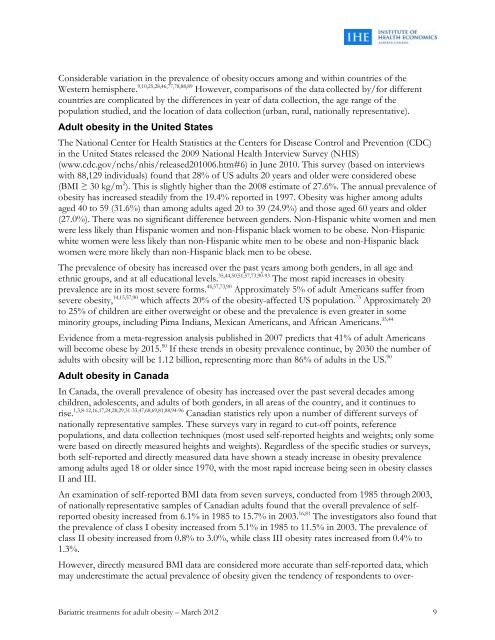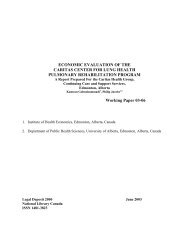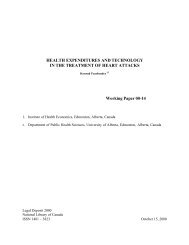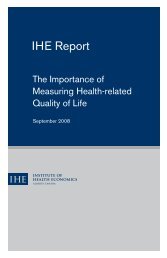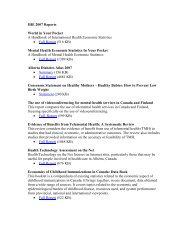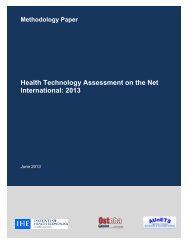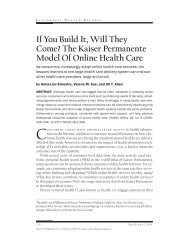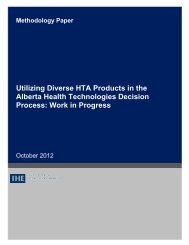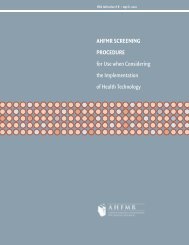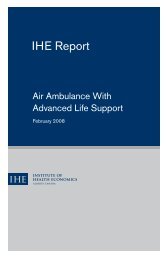Severe <strong>obesity</strong> is associated with decreased health-related quality <strong>of</strong> life (HRQoL), a term that refersto the burden <strong>of</strong> suffering and the limitations in physical, occupational/vocational, and socialfunctioning associated with illness. 1,6,39,40,52-55,57,67,68,72 Affected individuals frequently report that thepervasiveness and severity <strong>of</strong> their impairments are their strongest motivators <strong>for</strong> seeking bariatrictreatment. Additionally, impairments in HRQoL may account <strong>for</strong> increased symptoms <strong>of</strong> depression.Persons who have significant limitations in their functional abilities due to <strong>obesity</strong> could be expectedto have impaired occupational function. 39,40,54 Severe <strong>obesity</strong> has been associated with greatermorbidity and a poorer HRQoL than smoking/drinking problems (alcoholism) or poverty. 40Emotional suffering may be one <strong>of</strong> the most painful consequences <strong>of</strong> <strong>obesity</strong>. 1,6,12,19,25,39,40,53-55,57,58,60,70,75Socially, individuals with <strong>obesity</strong>, particularly those affected by severe <strong>obesity</strong>, have to deal withstigmatization, prejudice, discrimination, and social rejection/isolation. The prevalence <strong>of</strong> weightbias and discrimination in the United States has increased by 66% over the past decade and iscomparable to rates <strong>of</strong> racial discrimination, especially among women. 75Society emphasizes physical appearance and <strong>of</strong>ten equates attractiveness with slimness, especially <strong>for</strong>women. 19,39,40,53-55,57,58,60,70,75,76 Obesity is <strong>of</strong>ten viewed as the physical manifestation <strong>of</strong> a character flaw,and the psychosocial problems <strong>of</strong> individuals with <strong>obesity</strong> are attributed to their character ratherthan to their condition. Also, weight bias and discrimination translate into inequities in employmentsettings, health-care facilities, and educational institutions. As a result, obese individuals feelmisunderstood and neglected.Epidemiology <strong>of</strong> <strong>adult</strong> <strong>obesity</strong> and population dynamics <strong>of</strong> affected individualsOver the past several decades, the worldwide prevalence <strong>of</strong> <strong>obesity</strong> (BMI ≥ 30 kg/m 2 ) has increasedsteadily among all demographic groups and countries with developed market economies are leadingthe way. 1,6,7,13,23-25,31,38,42,44,46,56,73,74,77-80 The <strong>obesity</strong> subgroups experiencing the most rapid growth arethe severe/extreme/morbid class and the moderate class (class III and class II, when BMI reaches40 kg/m 2 or even only 35 kg/m 2 if associated with comorbidities). 11,29,68,73,74,77,81-83The latest World <strong>Health</strong> Organization estimates indicate that globally in 2005 at least 400 million<strong>adult</strong>s were obese and, projecting that, by 2015 more than 700 million <strong>adult</strong>s will be obese(www.who.int/mediacentre/factsheets/fs311/en/index.html, accessed 23 July 2010). According tothe WHO, there are 300 million <strong>adult</strong>s with class I or II <strong>obesity</strong> and 30 million with class III<strong>obesity</strong>. 79The prevalence is rising at an even faster rate among children and adolescents. 2,27,56,61,69 TheInternational Obesity Task Force estimates that more than 155 million children worldwide areoverweight or obese. 56 According to the WHO, worldwide, at least 20 million children under the age<strong>of</strong> 5 were overweight in 2005 (www.who.int/mediacentre/factsheets/fs311/en/index.html, accessed23 July 2010).At the same time, the prevalence <strong>of</strong> <strong>obesity</strong> is rapidly increasing in the elderly population; this hasbecome a growing concern. 14,15,56,61,63-66,78,84-87The reported gap in <strong>obesity</strong> prevalence between women and men is usually small and the ratesincrease <strong>for</strong> both men and women, up to age 60 to 69, and then decline. 6,17,25,28,29,38,43,44,46,61,77,88 Studiesin countries with developed market economies have usually noted an inverse relationship betweenBMI and socioeconomic status, particularly among women. 10,28,43,88,89<strong>Bariatric</strong> <strong>treatments</strong> <strong>for</strong> <strong>adult</strong> <strong>obesity</strong> – March 2012 8
Considerable variation in the prevalence <strong>of</strong> <strong>obesity</strong> occurs among and within countries <strong>of</strong> theWestern hemisphere. 9,10,25,28,46,77,78,88,89 However, comparisons <strong>of</strong> the data collected by/<strong>for</strong> differentcountries are complicated by the differences in year <strong>of</strong> data collection, the age range <strong>of</strong> thepopulation studied, and the location <strong>of</strong> data collection (urban, rural, nationally representative).Adult <strong>obesity</strong> in the United StatesThe National Center <strong>for</strong> <strong>Health</strong> Statistics at the Centers <strong>for</strong> Disease Control and Prevention (CDC)in the United States released the 2009 National <strong>Health</strong> Interview Survey (NHIS)(www.cdc.gov/nchs/nhis/released201006.htm#6) in June 2010. This survey (based on interviewswith 88,129 individuals) found that 28% <strong>of</strong> US <strong>adult</strong>s 20 years and older were considered obese(BMI ≥ 30 kg/m 2 ). This is slightly higher than the 2008 estimate <strong>of</strong> 27.6%. The annual prevalence <strong>of</strong><strong>obesity</strong> has increased steadily from the 19.4% reported in 1997. Obesity was higher among <strong>adult</strong>saged 40 to 59 (31.6%) than among <strong>adult</strong>s aged 20 to 39 (24.9%) and those aged 60 years and older(27.0%). There was no significant difference between genders. Non-Hispanic white women and menwere less likely than Hispanic women and non-Hispanic black women to be obese. Non-Hispanicwhite women were less likely than non-Hispanic white men to be obese and non-Hispanic blackwomen were more likely than non-Hispanic black men to be obese.The prevalence <strong>of</strong> <strong>obesity</strong> has increased over the past years among both genders, in all age andethnic groups, and at all educational levels. 35,44,50,51,57,73,90-93 The most rapid increases in <strong>obesity</strong>prevalence are in its most severe <strong>for</strong>ms. 44,57,73,90 Approximately 5% <strong>of</strong> <strong>adult</strong> Americans suffer fromsevere <strong>obesity</strong>, 14,15,57,90 which affects 20% <strong>of</strong> the <strong>obesity</strong>-affected US population. 73 Approximately 20to 25% <strong>of</strong> children are either overweight or obese and the prevalence is even greater in someminority groups, including Pima Indians, Mexican Americans, and African Americans. 35,44Evidence from a meta-regression analysis published in 2007 predicts that 41% <strong>of</strong> <strong>adult</strong> Americanswill become obese by 2015. 50 If these trends in <strong>obesity</strong> prevalence continue, by 2030 the number <strong>of</strong><strong>adult</strong>s with <strong>obesity</strong> will be 1.12 billion, representing more than 86% <strong>of</strong> <strong>adult</strong>s in the US. 90Adult <strong>obesity</strong> in CanadaIn Canada, the overall prevalence <strong>of</strong> <strong>obesity</strong> has increased over the past several decades amongchildren, adolescents, and <strong>adult</strong>s <strong>of</strong> both genders, in all areas <strong>of</strong> the country, and it continues torise. 1,3,8-12,16,17,24,28,29,31-33,47,68,69,81,88,94-96 Canadian statistics rely upon a number <strong>of</strong> different surveys <strong>of</strong>nationally representative samples. These surveys vary in regard to cut-<strong>of</strong>f points, referencepopulations, and data collection techniques (most used self-reported heights and weights; only somewere based on directly measured heights and weights). Regardless <strong>of</strong> the specific studies or surveys,both self-reported and directly measured data have shown a steady increase in <strong>obesity</strong> prevalenceamong <strong>adult</strong>s aged 18 or older since 1970, with the most rapid increase being seen in <strong>obesity</strong> classesII and III.An examination <strong>of</strong> self-reported BMI data from seven surveys, conducted from 1985 through 2003,<strong>of</strong> nationally representative samples <strong>of</strong> Canadian <strong>adult</strong>s found that the overall prevalence <strong>of</strong> selfreported<strong>obesity</strong> increased from 6.1% in 1985 to 15.7% in 2003. 16,81 The investigators also found thatthe prevalence <strong>of</strong> class I <strong>obesity</strong> increased from 5.1% in 1985 to 11.5% in 2003. The prevalence <strong>of</strong>class II <strong>obesity</strong> increased from 0.8% to 3.0%, while class III <strong>obesity</strong> rates increased from 0.4% to1.3%.However, directly measured BMI data are considered more accurate than self-reported data, whichmay underestimate the actual prevalence <strong>of</strong> <strong>obesity</strong> given the tendency <strong>of</strong> respondents to over-<strong>Bariatric</strong> <strong>treatments</strong> <strong>for</strong> <strong>adult</strong> <strong>obesity</strong> – March 2012 9
- Page 1 and 2: Alberta STE ReportBariatric treatme
- Page 3 and 4: Alberta STE ReportBariatric treatme
- Page 5 and 6: EXECUTIVE SUMMARYSocial and System
- Page 7 and 8: Three surgical procedures—adjusta
- Page 9: Costs of Bariatric Surgery and Pote
- Page 12 and 13: Regulatory status .................
- Page 14 and 15: TABLES AND FIGURESSection One: Soci
- Page 16 and 17: ABBREVIATIONSAll abbreviations that
- Page 18 and 19: LYMmMAMDMUHCNANHLBINHSNICENIHNNHNPH
- Page 20 and 21: Bariatric physician: a licensed Doc
- Page 22 and 23: High-density lipoprotein (HDL): a f
- Page 24 and 25: Very-low-calorie diet (VLCD): a die
- Page 26 and 27: Additional Internet searches were c
- Page 28 and 29: This report addresses obesity in ad
- Page 30 and 31: Many systemic factors have been ide
- Page 34 and 35: eport their height and under-report
- Page 36 and 37: Also using self-reported data from
- Page 38 and 39: An examination of overall obesity d
- Page 40 and 41: Table S.2 presents the associationa
- Page 42 and 43: • have multiple focal points and
- Page 45 and 46: The main problem in any weight mana
- Page 47: food, and a negative body image. As
- Page 50 and 51: directly causes death. 61 To the ex
- Page 52 and 53: The addition of a selected pharmaco
- Page 54 and 55: lack of formal training in nutritio
- Page 56 and 57: slightly more likely to have prescr
- Page 58 and 59: selection criteria, have facilities
- Page 60 and 61: Barriers to using appropriate baria
- Page 62 and 63: Overview of adult obesityOver the p
- Page 64 and 65: the need for regular physical activ
- Page 66 and 67: phenylpropanolamine/25. Sibutramine
- Page 68 and 69: Complianceand AdherenceDemand andut
- Page 70 and 71: Aetna Clinical PolicyBulletinswww.a
- Page 72 and 73: Overweight 123,821 172,971 157,623
- Page 74 and 75: REFERENCES1. 2006 Canadian clinical
- Page 76 and 77: 34. Gostin LO. Fast and supersized:
- Page 78 and 79: 69. Klarenbach S, Padwal R, Wiebe N
- Page 80 and 81: 105. Hill JO, Thompson H, Wyatt H.
- Page 82 and 83:
141. Ross R, Bradshaw AJ. The futur
- Page 84 and 85:
172. Arkinson J, Ji H, Fallah S, Pe
- Page 86 and 87:
This section will address a set of
- Page 88 and 89:
dietary therapy is to reduce total
- Page 90 and 91:
Additional benefits of exercise ove
- Page 92 and 93:
medications that inhibit intestinal
- Page 94 and 95:
Rimonabant may be considered for pa
- Page 96 and 97:
Long-term complications are specifi
- Page 98 and 99:
Devices used for bariatric surgeryH
- Page 100 and 101:
Description of the Included Systema
- Page 102 and 103:
AEs for sibutramineAs compared to a
- Page 104 and 105:
Evidence on Efficacy/EffectivenessW
- Page 106 and 107:
Table T.7: Effects of behavioural t
- Page 108 and 109:
SurgeryDescription of the included
- Page 110 and 111:
follow-up time was 3 years. Results
- Page 112 and 113:
group as compared to the VBG group.
- Page 114 and 115:
The authors identified many methodo
- Page 116 and 117:
The investigators pointed out that
- Page 118 and 119:
approximately 3 to 5 kilograms. For
- Page 120 and 121:
for studies with a mean age of part
- Page 122 and 123:
Examining whether use of any of the
- Page 124 and 125:
Evidence from placebo-controlled cl
- Page 126 and 127:
colorectal or gastroesophageal or f
- Page 128 and 129:
Web of ScienceISI Interface License
- Page 130 and 131:
AMA Clinical PracticeGuidelineswww.
- Page 132 and 133:
critical appraisal of the included
- Page 134 and 135:
APPENDIX T.B: EXCLUDED STUDIESTable
- Page 136 and 137:
Padwal R, Li SK, Lau DC. Long-term
- Page 138 and 139:
Quality subsection 1: At least MEDL
- Page 140 and 141:
Quality subsection 5a:Study quality
- Page 142 and 143:
Partially reported: The study types
- Page 144 and 145:
Table T.C.1: Results of quality ass
- Page 146 and 147:
Table T.C.1: Results of quality ass
- Page 148 and 149:
APPENDIX T.D: CHARACTERISTICS OF SY
- Page 150 and 151:
Table T.D.1: Characteristics of the
- Page 152 and 153:
Table T.D.1: Characteristics of the
- Page 154 and 155:
Table T.D.2: Characteristics of the
- Page 156 and 157:
APPENDIX T.E: EVIDENCE TABLE ON SAF
- Page 158 and 159:
Serious surgical complicationsSurgi
- Page 160 and 161:
LSGmMAMDNAnssORQoLRCTRDRRRYGBSBPTGV
- Page 162 and 163:
Table T.F.1-2: Weight loss - Behavi
- Page 164 and 165:
Table T.F.1-4: Weight loss - Surger
- Page 166 and 167:
Table T.F.2: Quality of life (QoL)
- Page 168 and 169:
Curioni & Lourenco 2005 58Cholester
- Page 170 and 171:
Table T.F.3-3: Risk factors/comorbi
- Page 172 and 173:
Table T.F.3-5: Long-term effects of
- Page 174 and 175:
Maciejewski et al., 2005 65Avenell
- Page 176 and 177:
Table T.G.2: Effects of bariatric s
- Page 178 and 179:
Table T.G.4: Effects of bariatric s
- Page 180 and 181:
18. Cerulli J, Lomaestro BM, Malone
- Page 182 and 183:
50. Health Canada Drug Product Data
- Page 184 and 185:
SECTION THREE: ECONOMIC EVALUATIONC
- Page 186 and 187:
Definition of bariatric surgical pa
- Page 188 and 189:
etween surgical interventions, the
- Page 190 and 191:
concluded that adding orlistat to L
- Page 192 and 193:
Weight management program (WMP) ver
- Page 194 and 195:
groups. Compared with standard care
- Page 196 and 197:
Results from Analysis of Provincial
- Page 198 and 199:
DiscussionThe objectives of the eco
- Page 200 and 201:
surgical suites, and so on. The bud
- Page 202 and 203:
APPENDIX E.A: LITERATURE SEARCH SUM
- Page 204 and 205:
CRD Databases(DARE, HTA & NHS EED)h
- Page 206 and 207:
Web of ScienceISI Interface License
- Page 208 and 209:
NEOS Librarywww.library.ualberta.ca
- Page 210 and 211:
Table E.A.2: Evidence table of revi
- Page 212 and 213:
ResultHealth outcomesCostsMarginal
- Page 214 and 215:
CostsMarginal analysisThe cost anal
- Page 216 and 217:
Time Horizon/discount rateCurrency/
- Page 218 and 219:
Objectivestudy perspective: society
- Page 220 and 221:
ResultHealth outcomesCostsMarginal
- Page 222 and 223:
ResultHealth outcomesCostsMarginal
- Page 224 and 225:
S4Economic burden of obesityMean co
- Page 226 and 227:
15. Lacey LA, Wolf A, O'shea D, Ern
- Page 228 and 229:
Author Contribution StatementsPaula


